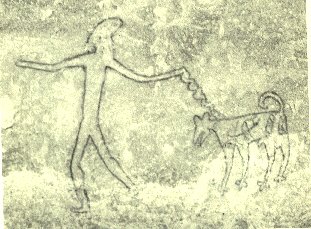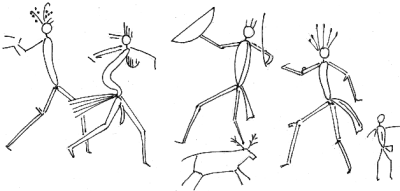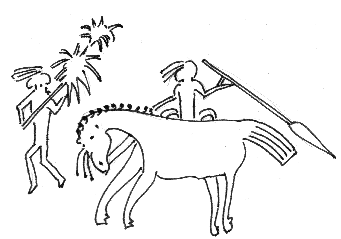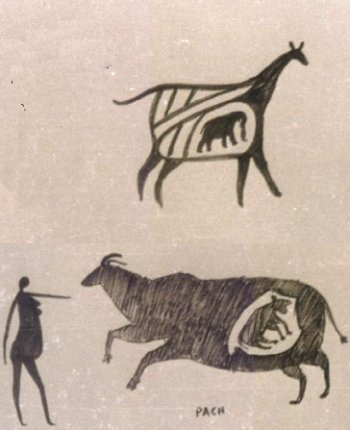by Dr. K. L. Kamat
First Online: August 15, 1997
Page Last Updated: January 20, 2012
Page Last Updated: January 20, 2012

Hunting a deer
Notice the grass in the deer's stomach.
 These rock paintings mirror
the difficulties and triumphs of the native man. These rock paintings mirror
the difficulties and triumphs of the native man. |
© K. L. Kamat

Pet or tool ? Man walks a dog
Rock Painting, Madhya Pradesh
The students of these rock paintings must take to some adventure. Due to the constant
battering of nature and mankind the foundations of art treasures has collapsed and it is
not easy to get to the top. It is common for peacocks and bats to dwell in these havens,
but sometimes one might run into porcupines, bear, or poisonous snakes, and one has to
very careful every step. The caves are typically pitch dark and takes time to locate any
paintings on their walls. Sometimes the paintings are located at the entrance, but those
interior are in much better shape because of protection from rain. Some native artists
were truly adventuresome and it takes a lot of effort even to get to some of the paintings

Pet or tool ? Man walks a dog
Rock Painting, Madhya Pradesh
© K. L. Kamat

Encircling the prey
I do not believe these paintings were drawn either to decorate to caves or to find
entertainment. They were created as a means of escape from suffering and as devotion to
supernatural entity. Most of them are not planned or organized nicely. Some have not taken
the trouble to erase older paintings before drawing the new ones on them. In a few spots,
I found four or five layers of sketches on top of another. The colors and the styles of such
layers, however, are different and have enabled the experts to separate one from another.
There are red, green, and white colors in all hues and varieties. The same pigments were
used to decorate the dead and it is common to find these colors in funeral spots also. The
paintings were done primarily with a finger, but I believe that they must have used
feathers, wooden sticks, and needles of porcupines for different styles and textures. 
Encircling the prey
Since the native man was not bound by any artistic constraints, the pictures come to life in full freedom and expression. The native man was an expert in simplifying life; he has drawn animals and birds with just two or three strokes. He has also made a good use of symbols and highlights, so a trunk denotes an elephant, a long feather represents a peacock, and a decorative horn illustrates a female deer. Some are single line sketches, and some are finished with a fair stroke. Some are really attractive with colors and shades.
© K. L. Kamat

Welcome to a Hero
The background of the rock paintings is obscure and is hard to
photograph the paintings. Most of them have lost the sharpness and luster.
Some are extremely fuzzy and ruined. I had to use special contrast film
and filters to photograph them. I could have sprayed the water on them for
better contrast, but the water with its alkaline contents damage the
originals, and there was no way for me to carry chemicals and other gear
to that remote location. I have taken the easy route out and have drawn
the line drawings in this page based on my photographs. When compared to
originals these pictures may look artificial, yet I hope that they
resemble the originals as perceived by the original artists.
Welcome to a Hero
© K. L. Kamat

Imagination or Ignorance?
The animals and birds constitute the largest subject of these paintings.
Some animals are silhouettes, yet very attractive. He has used triangles,
rectangles, circles, and hexagons freely. Sometimes he has shown the
internals of animals as if they were transparent. Some experts have
criticized these paintings as proof of the artist's ignorance, but I feel
that this proof that the native men studied their surroundings and nature.
I also think embedding an elephant in a deer's stomach as imagination and
humor. You can see a deer running away from a lion, animals crying for
help to the hunters, men running away from wild boars etc.
The ancient artists cared little for the details. Like the modern
artists, it must have been the feeling to be conveyed was the most
important for him. I also feel that he has done great injustice to the
women of his time. Among the thousands of pictures, less than ten show
women. In this aspect, the rock paintings of Bhimabetaka differ from the
cave paintings of Spain which are about of the same period. Since the
Spanish painters were desiring renewal of life, the sexes and the organs
are given primary importance. Few Bhimabetaka paintings show sexual
organs. Sometimes to identify a woman they have drawn a small vagina, but
has left out the breasts. However, in some spots to glorify women they
have drawn large breasts with fountains of milk coming
out of them.

Imagination or Ignorance?
These rock paintings mirror the difficulties of the native man's struggle with life as also his accomplishments. You can see rock weaponry, bows, arrows, and then the knives. He wove baskets with bamboo and started climbing the trees. He learned how to weave a rope from tree bark and cloth from the fibers. He must have used fish bones as needle and trained dogs for hunting. About this time he also learned raising of birds for food.
As the civilization progressed there were fights among tribes. There are lots of pictures in Bhimabetaka which illustrates ferocious warfare among humans. Since there are no signs of horses in the neighborhood of Bhimabetaka, the ones in the picture were probably confiscated from raiding invaders.
© K. L. Kamat

Group dance
After the daily life became easier, the native man turned to dancing in
music. There are pictures of group dance, mask dance, and stick dance.
Although it's a common concept that the native man was naked, the artist
has drawn clothes on all the dancers. It's possible
that the clothing was unisex.
Group dance
As a person who went to find the similarities between current day tribals and native tribals, I was dumbfounded by the similarities in their lifestyle. The tribals of Madhya Pradesh have lived monotonous lifestyles for thousands of years. Even today the Adivasis (aa-di-vaa-si, from Sanskrit, native) draw animals and birds on their walls consisting of triangles and circles for success in hunting. They also have unisex clothing, hunting with bows and arrows, and group dances. If someone studies the similarities between the two cultures, several generations of lost lifestyles may be uncovered.
No comments:
Post a Comment